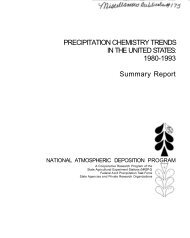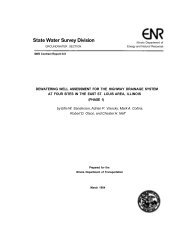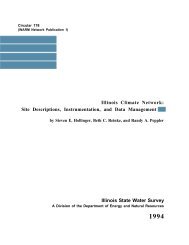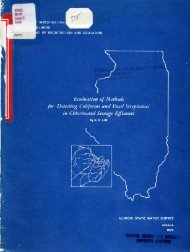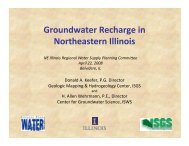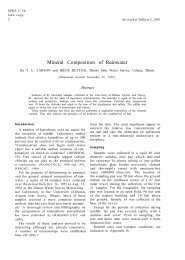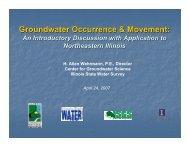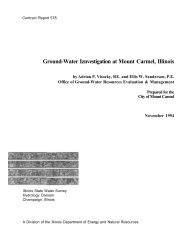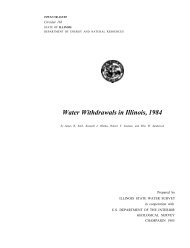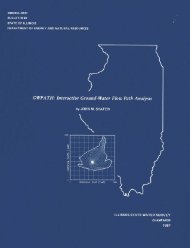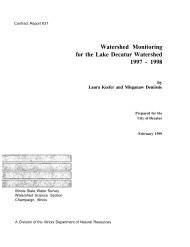Ground-water development in East St. Louis area, Illinois. Urbana, IL ...
Ground-water development in East St. Louis area, Illinois. Urbana, IL ...
Ground-water development in East St. Louis area, Illinois. Urbana, IL ...
You also want an ePaper? Increase the reach of your titles
YUMPU automatically turns print PDFs into web optimized ePapers that Google loves.
A network spac<strong>in</strong>g of 1 <strong>in</strong>ch equals 2000 feet was<br />
selected to m<strong>in</strong>imize the errors due to f<strong>in</strong>ite-difference<br />
approximation. Equations given by Karplus (1958) suggest<br />
that the selected network spac<strong>in</strong>g is adequate.<br />
By the process of trial and error, scale factors were<br />
chosen so that readily available and <strong>in</strong>expensive resistors<br />
and capacitors and exist<strong>in</strong>g excitation-response apparatus<br />
could be used.<br />
Selected analog scale factors are given below:<br />
A maximum pump<strong>in</strong>g period, t d , of 5 years was<br />
chosen, which is a sufficient period for <strong>water</strong> levels to<br />
stabilize under the <strong>in</strong>fluence of recharge from the Mississippi<br />
River. Accord<strong>in</strong>g to equation 28, with a K 4 =<br />
1.826X10 5 days/sec and when t d = 5 years, the pulse<br />
duration, t 8 , is equal to 10 -2 seconds. The pulse generator<br />
has a maximum pulse duration of 10 -2 seconds. A scale<br />
factor K 2 of 1 ft/volt was selected for ease <strong>in</strong> read<strong>in</strong>g the<br />
oscilloscope graph.<br />
A generalization of equations 23 and 24 permits account<strong>in</strong>g<br />
for variations <strong>in</strong> space of the coefficients of<br />
transmissibility and storage by vary<strong>in</strong>g resistors and<br />
capacitors. Fixed carbon resistors with tolerances of ±<br />
10 percent and ceramic capacitors with tolerances of ±<br />
10 percent were used <strong>in</strong> construct<strong>in</strong>g the analog model.<br />
Values of resistors were computed from equation 30<br />
us<strong>in</strong>g data on the coefficient of transmissibility given <strong>in</strong><br />
figure 25. Values of resistors <strong>in</strong> the <strong>in</strong>ternal parts of<br />
the model range <strong>in</strong> magnitude from 470,000 ohms near<br />
the bluff where T is about 20,000 gpd/ft to 33,000 ohms<br />
near Monsanto where T is about 330,000 gpd/ft. Resistors<br />
are greatest <strong>in</strong> magnitude, 2,200,000 ohms, along the valley<br />
wall where the coefficient of transmissibility is<br />
about 5000 gpd/ft<br />
Values of the capacitors of the <strong>in</strong>terior portions of<br />
the model were computed from equation 31 to be 2500<br />
micro-micro farads. The long-term coefficient of storage<br />
substituted <strong>in</strong> equation 31 was 0.15.<br />
Excitation-Response Apparatus<br />
The excitation-response apparatus consists of three<br />
major parts as shown <strong>in</strong> figure 60: a waveform generator,<br />
a pulse generator, and an oscilloscope. The waveform<br />
generator which produces sawtooth pulses is connected<br />
to the trigger circuits of the pulse generator and<br />
oscilloscope, thereby controll<strong>in</strong>g the repetition rate of<br />
computation and synchroniz<strong>in</strong>g the oscilloscope's horizontal<br />
sweep and the output of the pulse generator. The<br />
pulse generator, which produces rectangular pulses of<br />
various duration and amplitude upon command from the<br />
waveform generator, is coupled to that junction <strong>in</strong> the<br />
analog model represent<strong>in</strong>g the pumped well. The oscilloscope<br />
is connected to junctions of the analog model where<br />
it is desired to determ<strong>in</strong>e the response of the analog<br />
model to excitation. An electron beam is swept across<br />
the cathode ray tube of the oscilloscope provid<strong>in</strong>g a<br />
time-voltage graph which is analogous to the time-drawdown<br />
graph for an observation well. The waveform generator<br />
sends a positive pulse to the oscilloscope to start<br />
its horizontal sweep; at the same time, it sends a negative<br />
sawtooth waveform to the pulse generator. At a<br />
po<strong>in</strong>t along the sawtooth waveform the pulse generator<br />
is triggered to produce a negative rectangular pulse. The<br />
duration of this pulse is analogous to the pump<strong>in</strong>g period,<br />
t d , and the amplitude is analogous to the pump<strong>in</strong>g<br />
rate, Q. This pulse is sensed by the oscilloscope as a function<br />
of the analog model components, boundary conditions,<br />
and node position of the junction connected to the<br />
oscilloscope. Thus, the oscilloscope trace is analogous to<br />
the <strong>water</strong>-level fluctuation that would result after a step<br />
function-type pumpage change of known duration and<br />
amplitude. To provide data <strong>in</strong>dependent of the pulse<br />
repetition rate, the <strong>in</strong>terval between pulses is kept several<br />
times the longest time constant <strong>in</strong> the analog model.<br />
The time constant is the product of the capacitance at a<br />
po<strong>in</strong>t and the resistance <strong>in</strong> its discharge path.<br />
A means of comput<strong>in</strong>g the pump<strong>in</strong>g rate is <strong>in</strong>corporated<br />
<strong>in</strong> the circuit between the pulse generator and the<br />
analog model by the small resistor, R i , <strong>in</strong> series, shown<br />
<strong>in</strong> figure 59. Substitution of Ohm's law <strong>in</strong> equation 27 results<br />
<strong>in</strong> the follow<strong>in</strong>g equation which may be used to<br />
compute the pump<strong>in</strong>g rate:<br />
where:<br />
(32)<br />
The voltage drop across the calibrated resistor is<br />
measured with the oscilloscope. Switches S 1 and S 2 are<br />
closed and opened, respectively, and the oscilloscope is<br />
connected to the pumped well junction. The waveform <strong>in</strong><br />
figure 60C appears on the cathode ray tube; the vertical<br />
distance as shown is the desired voltage drop, V R .<br />
The switches S 1 and S 2 are returned to their orig<strong>in</strong>al<br />
positions. The oscilloscope is then connected to all junctions<br />
of the analog model represent<strong>in</strong>g observation wells.<br />
The screen of the oscilloscope is accurately calibrated so<br />
that voltage and time may be used on the vertical and<br />
horizontal axis, respectively. The time is <strong>in</strong> seconds;<br />
the value of each horizontal division on the screen is<br />
determ<strong>in</strong>ed by not<strong>in</strong>g the duration of the rectangular<br />
pulse and the number of divisions covered by the timevoltage<br />
trace for a junction adjacent to the pumped well.<br />
The time-voltage graphs obta<strong>in</strong>ed from the oscilloscope<br />
can be converted <strong>in</strong>to time-drawdown graphs with equa-<br />
54




